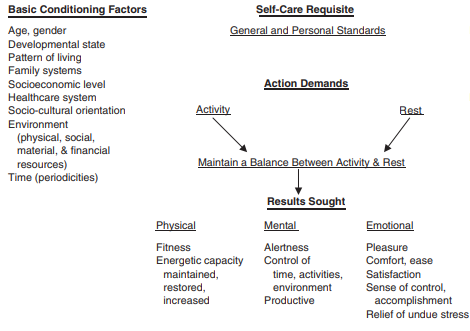Introduction
In achieving the goal of self-care, one must create a balance between activity and rest. The meaning of both words is different for different people. Activity does not always mean physical activity and includes other non-physical forms of activity. In terms of rest, it can consist of either the conservation, restoration, or expenditure of energy. Psychological relief may be derived from strenuous activity and physical relief may be derived from non-strenuous activity. However, “Activities that are restful for one person, then, may not be so for another.” (Allison, 2007) Methods of rest run on a case-by-case basis that is determined by personal preferences.

Example SMART Goal
S: I want to devote at least an hour to myself for a personal break/rest period each day
M: I will know when I achieved each instance of rest by a timer or by checking the time.
A: Devoting at least an hour to myself is plausible.
R: This goal is important to me so I don’t burn out and it will support my mental health.
T:I’m going to try to do this within the next 2 weeks.
More on Rest/Breaks
- https://www.betterup.com/blog/types-of-rest
- http://thegrowtheq.com/how-to-actually-get-some-rest-for-once/
Works Cited:
Allison, Sarah E. “Self-Care Requirements for Activity and Rest: An Orem Nursing Focus.” Nursing Science Quarterly, vol. 20, no. 1, Jan. 2007, pp. 68–76. EBSCOhost, https://doi.org/10.1177/0894318406296297 .
